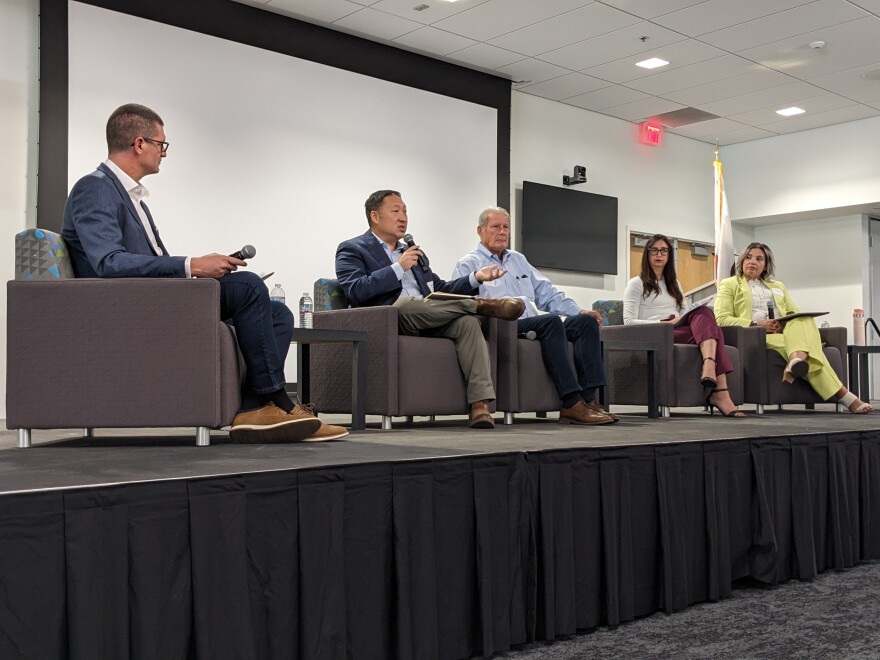FRESNO, Calif. – For years, conversations about the Sustainable Groundwater Management Act – known commonly as SGMA – have largely taken a tone of speculation and even apprehension.
The 2014 law, which aims to slow California’s unlimited tapping of underground aquifers, gives locally organized groundwater sustainability agencies until 2042 to overhaul pumping practices for the spectrum of groundwater users — from cities and rural communities to dairies, small farms and agricultural conglomerates.
Ultimately, the consequences could be dire: the non-profit Public Policy Institute of California predicted even in the best-case scenario, as much as 500,000 acres of farmland may need to be fallowed in order to adequately reduce groundwater pumping.
Now, nine years into SGMA’s rollout, public conversations are evolving from planning water-saving projects to implementing them.
This was evident last week, when water leaders from across the state gathered for a conference at Fresno State. The convening, organized by the PPIC, presented a SGMA progress report and included panels of government officials as well as farmers, elected leaders and community advocates.
Karla Nemeth, director of the state Department of Water Resources, noted attitudes are changing and more people are willingly coming to the table to discuss SGMA.
“It just opens up conversations we weren't really able to have in a serious way,” she said. “It’s not to say that it’s not going to continue to be quite difficult, but to give ourselves a chance to be optimistic for certain reasons…I think that’s terrific.”
This is more of a conversation about, ‘What can we do with the lands for which there are no other options?’Caitlin Peterson, PPIC associate director
Farmers are getting on board
Aaron Fukuda, general manager of the Tulare Irrigation District and interim general manager of the Mid-Kaweah Groundwater Sustainability Agency, agreed. He said he spends a lot of time on the phone talking about SGMA with farmers and other water users.
“I tell everybody it's a two-hour conversation,” he said. “The first hour they're yelling at you, and the second hour they're going, ‘OK, we’re going to do it, how can I be a part of it?’”
For all involved, being a part of SGMA’s implementation means not only finding ways to cut back on groundwater use, but also bringing water back into the system. Many groundwater sustainability agencies have plans to divert or store floodwater and build recharge basins for water to percolate back into the subsurface.
Don Cameron, general manager of Terranova Ranch and chairman of the McMullin Area Groundwater Sustainability Agency in Fresno County, shared that last spring, a series of pumps and canals successfully diverted flood flows into on-farm groundwater recharge.
“We're somewhere between 16 and 18, almost 19,000 acre-feet of water that we took and put on the land and put into the ground,” he said, noting that his agency plans to expand the project in the coming years. “When you've got farmers involved that have their livelihood at stake, they get pretty creative.”
Room for improvement remains
Self-Help Enterprises community development specialist Sonia Sanchez emphasized the importance of collaboration between groundwater sustainability agencies and the rural, sometimes disadvantaged, communities within their districts to ensure many voices are heard.
“It does vary, but some themes that we're seeing are that communities are not being engaged overall,” Sanchez said, noting that many of these agencies do not have any rural residents on their governing boards.
“That could be a space where residents could be more involved and have their voices heard.”
Meanwhile, many growers remain skeptical about repurposing their land. As a water cost-saving measure, many agencies are transitioning irrigated farmland into less water-intensive uses like solar farms, habitat restoration, or even dryland farming, which uses no irrigation.
Ralph Pistoresi, a Madera County farmer who attended the SGMA convening, shared his skepticism following a discussion of these options. He pointed to the breakfast buffet at the side of the room.
“All that fruit you ate over there today? You'd be eating oat hay, because that’s the only thing you can grow [by] dryland farming, on a wet year,” he said. “Most people eat three times a day, and unless they're going to eat oat hay or chew on a solar panel, you're not going to be happy.”
Caitlin Peterson, associate director of the PPIC and a research fellow, responded: “I don't think it's anybody's first choice to plant dryland oats or wheat instead of our wonderful diversity of fruits, vegetables, watermelons, almonds…This is more of a conversation about, ‘What can we do with the lands for which there are no other options?’”


